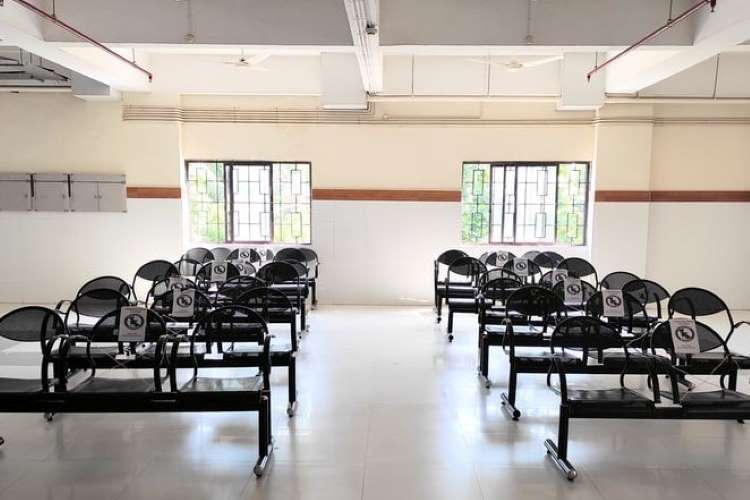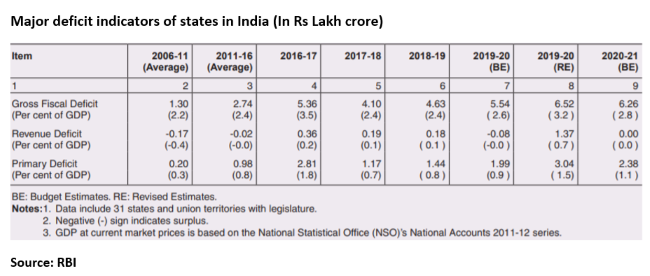
The Covid-19 pandemic has opened a pandora’s box of unprecedented fiscal and economic challenges across Indian states. High level of public debt, lower revenues and high expenditure to address the pandemic impact, and structural challenges limited the scope for expansionary fiscal policy responses at the state level. The gross fiscal deficit at the sub-national level has been budgeted at 2.8% of the gross state domestic product with an upside risk as the pandemic woes unfolded in FY2021.
A recent report on state finances by the Reserve Bank of India (RBI) estimated the actual fiscal stress and its impact on Indian states in the wake of the pandemic. Given the gravity of the current situation, what are the lessons learnt and what should be the way ahead to break the vicious circle of stagflation at the sub-national level?
READ I Atmanirbhar Bharat a non-starter without an MSME surge
Aligning finances at state level
The discretionary fiscal spending (total expenditure minus interest payments) of the states, especially the capital outlay, remained procyclical. This is currently at around 16% of the gross domestic product (GDP) compared with 13% during the pre-crisis era. This makes them vulnerable to pandemic shocks and the consequent economic slowdown.
The outstanding debt of state governments is growing at a rapid pace and the debt–GSDP ratio is estimated at 26.6% during FY2021. The increased fiscal responsibilities of the states have prompted them to finance fiscal deficit through enhanced market borrowings. States with gross fiscal deficits of 3% and less finance it through market borrowings. The gross borrowing of these states increased by 32.7% during FY2020.

High level of public debt limits the scope of fiscal support to recover from the pandemic-triggered economic crisis. Thus, recovery at state level may take more time. Moreover, there will be curtailment in expenses with respect to amenities such as water supply, sanitation, rural and urban development, energy and transport as well as education.
READ I Boon or bane? Universal basic income is not a poverty eradication tool
States that have be proactive in containing the virus spread are likely to get impacted to a great extent. Even as the primary focus of all states are on dealing the health emergency, spatial dimensions of characteristics like demography, health infrastructure, employment generation, digital preparedness and the involvement of local self-governments have been determining factors for a speedy economic recovery of Indian states.
Determining factors for a speedy economic recovery
The demography of the states serves as an important factor influencing fiscal position and economic growth, especially in the wake of the pandemic. States with younger population have the scope of early recovery while states like Kerala, Tamil Nadu and Himachal Pradesh, that have significantly higher proportion of older population are expected to drag the recovery process as selective restrictions are required to protect the vulnerable group of population. On the contrary, low income states like Bihar, Uttar Pradesh and Jharkhand are less vulnerable to the pandemic as they have a competitively younger population.
The correlation between demographic, epidemiological factors and fatalities from the pandemic reveals an intriguing picture. Ageing states which are more prone to the risk of Covid-19 have lesser fatality rates compared with others. Therefore, health infrastructure and access to health facilities played an important role in mitigating the impact of the pandemic and investment in healthcare becomes thus both prudent as well as urgent.
READ I Future perfect: Life after the fourth industrial revolution
States such as Bihar, UP, West Bengal, Madhya Pradesh, Odisha, Jharkhand, Uttarakhand and Jammu and Kashmir spend considerably less on healthcare with a sizable out of pocket expenditure. Kerala stands as an exception in this regard with high public and private spending on healthcare. Therefore, the state managed to keep the mortality rate lower despite unfavourable demography. The state of Punjab suffered a great extent with higher riskier proportion of population and poor healthcare spending. States with lower health spending still fared better in fighting the pandemic only due to favourable demographic profile.
The stringency of nation-wide as well as regional lockdowns impacted the informal sector labourers and resulted in large-scale reverse migration. The migrants became carriers of virus from urban to rural areas to an extent. The pandemic also called for serious policy actions to protect those categories of laborers who are currently deprived of income and employment.
Micro Medium and Small Enterprises (MSMEs) which are the biggest employment providers in the country in the non-farm sector have taken a hit with supply disruptions and demand shocks, both domestic and external. As per RBI report, the top 11 states accounting for around 82% of employment in MSMEs, also have a high incidence of COVID-19 cases and are bearing the brunt of reverse migration. In this case, Tamil Nadu, a key MSME hub of India, experienced one of the highest numbers of Covid-19 cases. The Aatmanirbhar Bharat Scheme attempted to address some key issues pertaining to this sector, however all those measures are likely to help MSMEs from the supply side and their effectiveness will depend on the revival of demand.
READ I India’s retail sector: Overcoming policy and structural challenges
The pandemic has alerted the policymakers with respect to digital preparedness of states. During the pandemic when social distancing norms were practiced, giving thrust on public work programmes became extremely challenging. Digital transfers became the channel of public intervention across the globe. Direct benefit transfer (DBT) was the only mode for providing relief to vulnerable sections of the population like small farmers, migrant labourers, women and senior citizens. On DBT score, Haryana topped the list with 88.8 points compared with the national average of 56.1. Goa has the highest percapita DBT transfer with Rs 4,705. Digitisation has thus emerged as an important parameter for states while fighting the pandemic.
Another important factor that drew a great deal of attention was the efficiency of the local self-government system. States that have strengthened their local government institutions with substantial devolution of funds and greater autonomy are managing the COVID-19 pandemic more efficiently. In this regard, the Kerala model has been getting wide attention, wherein the state could effectively reach out to affected people. These bodies were utilised for gathering information, charting out the route map of affected people and extending adequate help in terms of medical services and others. The devolution of funds to these bodies is much higher in Kerala compared with others states.
In short, coordinated policy responses and preparedness are crucial for speedy recovery from the economic devastation caused by the pandemic. The states that controlled the virus spread effectively are witnessing faster improvement in economic activities. The post pandemic planning and policy formulations at sub-national levels have a greater role in recovery from the vicious circle of growth deceleration. Required reorientation of policy thrust is needed in enhancing health infrastructure and related expenditures, as well as boosting investment in basic digital infrastructure for better and transparent delivery of public services. Acknowledging the role of local self-government and tapping its potential will be helpful for interventions at the grassroots level. Besides, the quality and vision of fiscal spending is highly warranted while fixing the economic damage and recovering from the economic crisis.
Dr. Aswathy Rachel Varughese is Assistant Professor at Gulati Institute of Finance and Taxation, Thiruvananthapuram, Kerala.

